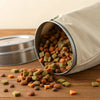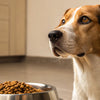How to Store Dry Dog Food After Opening: A Comprehensive Guide
- Houndsy
Table of Contents
- Introduction
- Understanding the Importance of Proper Storage
- How Long Does Dry Dog Food Last After Opening?
- Identifying Spoiled Dry Dog Food
- Proper Storage Techniques
- Common Mistakes to Avoid
- How to Extend the Freshness of Dry Dog Food
- Health Risks of Feeding Expired Dog Food
- Ensuring Nutritional Quality and Freshness of Dry Pet Food
- Conclusion
- FAQs
Introduction
Did you know that nearly 30% of pet owners unknowingly feed their dogs stale or spoiled food? It's a startling statistic that highlights a critical aspect of pet care: proper dog food storage. As devoted pet parents, we want to ensure that our furry friends receive the best nutrition possible, but many of us overlook how to store dry dog food after opening.
When it comes to maintaining the quality and safety of our pets' meals, understanding the nuances of food storage is essential. This blog post will delve into best practices for storing dry dog food to preserve its nutritional value and prevent spoilage. We'll explore the importance of proper storage methods, how to identify spoiled food, and tips for extending freshness. By the end of this article, you'll be equipped with practical knowledge to enhance your dog-feeding routine and ensure your canine companion enjoys every bite.
So, let’s embark on this journey together, reflecting on our current dog food storage methods. Are we doing everything we can to keep our pets’ food fresh and safe?
Understanding the Importance of Proper Storage
Proper storage of dry dog food is not just a matter of convenience—it's vital for our pets' health. Here are some key reasons why it’s essential to store dog food correctly:
- Preservation of Nutritional Quality: Exposure to air, moisture, and heat can degrade essential vitamins and fats in kibble. Storing food properly helps maintain its nutritional integrity.
- Prevention of Spoilage: Improperly stored food can lead to mold growth, rancidity, and bacterial contamination, which can pose serious health risks to our dogs.
- Keeping Pests Away: Rodents and insects are often attracted to improperly sealed food, leading to further contamination.
- Reducing Food Waste: Correct storage methods extend the shelf life of dog food, allowing us to use it before it goes stale.
- Maintaining Taste: Stale food may be unappetizing for our pets, impacting their willingness to eat.
As pet owners, we bear a responsibility to provide safe and nutritious meals for our dogs. Understanding how to store dry dog food after opening is a crucial step in fulfilling that duty.
How Long Does Dry Dog Food Last After Opening?
Once we open a bag of dry dog food, its freshness begins to decline. Generally, dry dog food remains at its best quality for about 4 to 6 weeks post-opening, assuming it’s stored correctly. Here’s a breakdown of factors affecting its shelf life:
- Storage Conditions: Temperature and humidity have a significant impact on freshness.
- Original Packaging: The design of the bag can help protect the food from environmental factors.
- Sealing: Properly sealing the bag or using airtight containers can prolong the food's freshness.
To ensure your dog’s diet remains balanced and safe, it’s essential to monitor the freshness of their food and use it within the recommended time frame.
Identifying Spoiled Dry Dog Food
Knowing how to recognize spoiled dry dog food is crucial for our pets' health. Here are some signs to watch for:
- Change in Smell: A strong or unusual odor can indicate spoilage. Fresh kibble should have a pleasant, mild smell.
- Alteration in Color: If the kibble appears discolored or looks different from when it was purchased, it may be spoiled.
- Texture Changes: Signs of dampness, crumbling, or a greasy feel can indicate that the food has been compromised.
- Presence of Mold or Insects: Any signs of mold growth or insect infestation mean the food should be discarded immediately.
If you notice any of these changes, it’s always best to err on the side of caution and dispose of the food. Your dog's health is paramount, and feeding spoiled food can lead to serious digestive issues.
Proper Storage Techniques
Now that we understand the importance of storage, let’s discuss the best practices for storing dry dog food after opening. Here are our top recommendations:
1. Store in a Cool, Dry Place
Keeping dry dog food in a cool, dry area is essential. Aim for a temperature below 80 degrees Fahrenheit. Avoid places subject to heat fluctuations, like garages or sheds, where temperatures can exceed 100 degrees Fahrenheit.
2. Use Airtight Containers
Investing in an airtight container is one of the best ways to protect dry dog food. Here are some options to consider:
- Plastic Containers: Look for BPA-free options made from food-grade plastic. These containers are generally lightweight and easy to handle.
- Stainless Steel Containers: These are durable and easy to clean, making them an excellent choice for long-term storage.
At Houndsy, our flagship product, the Houndsy Kibble Dispenser, exemplifies our commitment to innovative design and convenience. It combines ergonomic features with mid-century modern aesthetics, allowing you to store up to 30 lbs of kibble securely while enhancing your home decor.
3. Seal the Bag Properly
If you prefer to keep the kibble in its original bag, it’s crucial to seal it tightly after each use. Here are some tips to ensure optimal sealing:
- Roll Down the Bag: After scooping out the necessary amount, roll down the top of the bag to expel excess air and secure it with a bag clip.
- Store Inside an Airtight Container: For added protection, place the entire bag inside an airtight container. This way, you retain the original packaging, which includes crucial information like the UPC code and expiration date.
4. Avoid Frequent Opening
Every time we open the container, fresh air enters, which can accelerate the degradation of the food. Consider using a smaller container for daily use while keeping the bulk of the food in a larger, sealed container to minimize exposure.
5. Keep the Container Clean
Regularly washing your food containers is vital to prevent cross-contamination. Use hot, soapy water or vinegar to clean them thoroughly before refilling. Allow them to dry completely to avoid moisture buildup.
6. Store Away from Strong Odors
Dry dog food can absorb odors from its surroundings. Store it away from strong-smelling items like cleaning supplies or garbage to maintain its taste and quality.
Common Mistakes to Avoid
While we strive to provide the best for our pets, there are common pitfalls that can hinder our efforts in food storage. Here are some mistakes to watch out for:
- Not Checking Expiration Dates: Always verify the expiration date before purchasing and feeding dry dog food. Using food past its expiration can lead to nutritional deficiencies.
- Dumping Food Directly into Containers: While it may seem convenient, pouring kibble into a container can introduce moisture and contaminants. Consider keeping the original bag for added protection.
- Neglecting Cleanliness: Failing to wash scoops, bowls, and containers can introduce bacteria, accelerating spoilage. Ensure these items are cleaned regularly.
- Leaving Food in Bowls for Too Long: Dry kibble shouldn’t be left out for more than 24 hours. Uneaten portions should be discarded to avoid contamination.
How to Extend the Freshness of Dry Dog Food
To keep your dog’s kibble fresh for as long as possible, implement these additional strategies:
- Purchase Smaller Quantities: Buy amounts that can be consumed within a reasonable timeframe to ensure freshness.
- Vacuum Seal: If you have excess food, consider vacuum-sealing it in smaller portions for freezing. This method can extend its shelf life significantly.
- Monitor Conditions: Regularly check the storage conditions—temperature and humidity can fluctuate, so ensure they remain stable.
- Store in Whole Bags: As mentioned, keeping the kibble in its original packaging inside a container can provide an extra layer of protection.
Health Risks of Feeding Expired Dog Food
Feeding expired or spoiled dog food can lead to various health risks for our furry companions:
- Nutritional Deficiencies: Expired food loses its nutritional value, leading to deficiencies that can adversely affect your dog’s health.
- Gastrointestinal Issues: Spoiled food can harbor harmful bacteria like Salmonella and E. coli, leading to vomiting, diarrhea, and more severe health complications.
- Rancid Fats: Fats in dog food can become rancid over time, potentially causing digestive problems and toxic reactions in dogs.
For our dogs’ well-being, it’s crucial to prioritize proper storage methods and monitor their food closely.
Ensuring Nutritional Quality and Freshness of Dry Pet Food
Maintaining the nutritional quality of dry dog food is essential for our pets' overall health. Here are some key takeaways:
- Use Within Recommended Timeframes: Aim to consume opened dry dog food within 4 to 6 weeks for optimal freshness.
- Store Correctly: Use airtight containers in cool, dry places to protect against spoilage and maintain nutritional value.
- Check for Signs of Spoilage: Regularly inspect the food for changes in smell, color, or texture to avoid feeding spoiled kibble.
By adhering to these best practices, we can ensure our pets receive the highest quality nutrition.
Conclusion
In conclusion, knowing how to store dry dog food after opening is crucial for our pets' health and well-being. By understanding the importance of proper storage techniques, identifying spoiled food, and avoiding common mistakes, we can significantly enhance our dogs' feeding experience.
We encourage you to reflect on your current dog food storage methods. Are you doing everything possible to keep your furry friends' meals fresh and nutritious?
To take your dog feeding routine to the next level, consider exploring the Houndsy Kibble Dispenser. Our innovative design combines functionality and style, making it the perfect addition to your home.
FAQs
1. How long can I keep dry dog food after opening?
Dry dog food is best used within 4 to 6 weeks after opening, provided it is stored correctly.
2. Can I store dry dog food in its original bag?
Yes, it’s recommended to keep the kibble in its original bag and place it inside an airtight container for added protection.
3. What are the signs of spoiled dry dog food?
Look for changes in smell, color, texture, the presence of mold or insects, and any unusual odors.
4. How should I clean my dog food container?
Wash your dog food container with hot, soapy water or vinegar, and ensure it is completely dry before refilling.
5. Can I freeze dry dog food?
Yes, you can freeze dry dog food in an airtight container or vacuum-sealed bag to extend its shelf life significantly.












